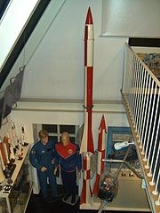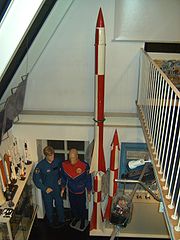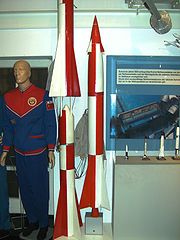
Rocket experiments in the area of Cuxhaven
Encyclopedia
Between 1933 and 1964 numerous rocket experiments were carried out in the area of Cuxhaven, Germany
.


Germany
Germany , officially the Federal Republic of Germany , is a federal parliamentary republic in Europe. The country consists of 16 states while the capital and largest city is Berlin. Germany covers an area of 357,021 km2 and has a largely temperate seasonal climate...
.
1930s and 1940s
- In April 1933 Gerhard ZuckerGerhard ZuckerGerhard Zucker was a German businessman and rocket engineer. However, none of his machinations proved to be operational, ranging from outright fraud to total failure....
launched a mail rocket, which was to fly from Duhnen to the island of NeuwerkNeuwerkNeuwerk is a Wadden Sea island on the German North Sea coast and a homonymous quarter of the city of Hamburg, Germany, in the borough Hamburg-Mitte...
, but which fell to Earth after flying a few meters.
- During World War IIWorld War IIWorld War II, or the Second World War , was a global conflict lasting from 1939 to 1945, involving most of the world's nations—including all of the great powers—eventually forming two opposing military alliances: the Allies and the Axis...
some test flights of F1-103 (V1)V-1 flying bombThe V-1 flying bomb, also known as the Buzz Bomb or Doodlebug, was an early pulse-jet-powered predecessor of the cruise missile....
rockets were flown from the military camp of Altenwalde. In 1945, Kurt Debus was ordered to install a launch pad for testing A4-rockets in the area of Cuxhaven, as a replacement for Stand VII in PeenemündePeenemündeThe Peenemünde Army Research Center was founded in 1937 as one of five military proving grounds under the Army Weapons Office ....
; however, the project could not be completed due to the military situation towards the end of the war. Nevertheless, in October 1945, these works supplied a basis for "Operation BackfireOperation Backfire (WWII)Operation Backfire was a military scientific operation during and after World War II, which was performed mainly by British staff. It was part of the Allies' scramble to loot as much German technology as they could....
", a demonstration of three A4-rocket launches to military representatives of the Allied Occupation Forces. One launch pad and two concrete shelters were built for "Operation Backfire", near the road between ArenschArenschArensch is a local part of Cuxhaven, a town in Lower Saxony, Germany. In the proximity of Arensch between 1945 and 1964 various rocket attempts were accomplished...
and SahlenburgSahlenburgSahlenburg is a borough of the city Cuxhaven near the mouth of the river Elbe in Lower Saxony, Germany. The Sahlenburg beach is popular with tourists. In addition to swimming in the sea when the tide permits, there are also walks into the Duhner and the Werner forests.The earliest artifacts...
, where some remnants still exist today.
1950s
- In 1952 in HespenbuschHespenbuschHespenbusch is a farm, which belongs to the municipality of Grossenkneten. Karl Poggensee and the Hermann Oberth society operated between 1952 and 1957 a launch site for small rockets with a maximum flight level of some kilometers, close to this farm...
, Karl Poggensee began to develop and launch small solid-propellant rockets. In the same year a Rocket/Technical Society was created, initially known as DAFRA, then as the German Rocket Society (Deutsche Raketengesellschaft) or DRG, and finally as the Hermann Oberth Society (Hermann-Oberth-Gesellschaft) or HOG.
- After a short time, this society built rockets with maximum altitudes of several kilometres, but the available area in Hespenbush was too small for their purpose, so a new launch area had to be found. On the recommendation of Cuxhaven town-councilor Geveke, who had worked during the war on the development of missiles, the coastal area of Cuxhaven was selected. This area was considered to be the most suitable, not only because of the "Operation Backfire" launches, but also because to the north and west of Cuxhaven was open sea, an ideal firing range.
- On August 24, 1957, the first rocket launches took place. Seven "oilspray" rockets with a range of 100 to 300 m were fired, followed by a launch of several small model rockets which reached up to 2 km of altitude. Then came a delta-winged rocket built by Koschmieder which reached 3 km. A prototype 20 kg meteorological rocket using a new solid propellant developed by Deutsche Dynamit AG produced 1500 kgfKGFKGF may refer to:*Keratinocyte Growth Factor*King George's Fields A UK set of 471 memorial playing fields and recreation grounds*Kolar Gold Fields*The IATA code for Sary-Arka Airport, Karaganda, Kazakhstan...
(15 kN), reaching a speed of Mach 1.5, and a height of 4 km. A test of the first of Ernst MohrErnst MohrErnst Mohr was a professor of mechanical engineering at the University of Wuppertal. He developed the meteorological Mohr Rocket, on behalf of the German Rocket Society...
's large rockets had been planned, but was canceled due to bad weather.
- The launch point of these rockets was close to the building yard of Arensch. In contrast to "Operation Backfire", there was no firm launch pad, however the control post was installed in a former World War II German Navy shelter.
- On June 8, 1958, the first attempted launches of Ernst Mohr's large meteorological rockets were made. The rockets had been so far improved that they could, theoretically, reach heights of 50 km, but there were problems with flight stability, and each of the three rockets fell.
- On September 14, 1958, the first successful flights of Ernst Mohr's rocketsMohr RocketThe Mohr Rocket was a sounding rocket developed by Ernst Mohr in Wuppertal, Germany.It was a single stage solid fuel rocket with:*a length of 1.7 metres,*a total mass of 150 kg ,*a lift-off thrust of 76.5 kN and a diameter of 0.3 m....
took place, with the payload dart reaching a height of 50 km.
- On May 16, 1959, the first mail-rockets were launched. These rockets carried 5000 postcards over a distance of 3 km. The letters transported with these rockets received special stamps which are nowadays greatly coveted by philatelistsPhilatelyPhilately is the study of stamps and postal history and other related items. Philately involves more than just stamp collecting, which does not necessarily involve the study of stamps. It is possible to be a philatelist without owning any stamps...
. The mail-rocket launches were also used to finance the rocket experiments.
- On November 1, 1959, the first launch of a KumulusKumulus (rocket)Kumulus is the name of a rocket of the "Hermann-Oberth-Gesellschaft e.V.". The first Kumulus rocket was launched on December 20, 1960 near Cuxhaven...
rocket took place. It reached a height of 15 km, however the on-board transmitter failed.
1960s


- On February 11 and February 12, 1961, the first launches of Kumulus rockets with scientific experiments succeeded, and it was possible to follow their progress by radio-tracking.
- In May and June 1961, mail was transported with rockets, for the first time, over a larger distance from the mainland to the islands of NeuwerkNeuwerkNeuwerk is a Wadden Sea island on the German North Sea coast and a homonymous quarter of the city of Hamburg, Germany, in the borough Hamburg-Mitte...
and Scharhörn.
- On September 16, 1961, two Kumulus rockets transporting biological experiments were launched. On board one of these rockets was a salamanderSalamanderSalamander is a common name of approximately 500 species of amphibians. They are typically characterized by a superficially lizard-like appearance, with their slender bodies, short noses, and long tails. All known fossils and extinct species fall under the order Caudata, while sometimes the extant...
called Max, and on board the other there was a goldfishGoldfishThe goldfish is a freshwater fish in the family Cyprinidae of order Cypriniformes. It was one of the earliest fish to be domesticated, and is one of the most commonly kept aquarium fish....
called Lotte. Lotte landed safely after the flight, while Max did not survive a hard landing caused by a parachute failure. On the same day the first flight of the sounding rockets CirrusCirrus (rocket)The Cirrus is a sounding rocket with two stages, developed by the "Hermann Oberth Society". Its first launch was on September 16, 1961. The maximum height of the Cirrus, depending on the version, is 35 kilometres or 50 kilometres. A Cirrus rocket is exhibited at the Hermann Oberth Space Travel...
I and II took place. These rockets reached maximum altitudes of 35 and 50 km, respectively.
- In 1961, the rocket engineer Berthold Seliger founded his rocket construction company Berthold-Seliger-Forschungs- und Entwicklungsgesellschaft mbHSeliger Forschungs- und Entwicklungsgesellschaft mbHThe Berthold Seliger Forschungs- und Entwicklungsgesellschaft mbH was a company founded by German rocket technical designer Berthold Seliger in 1961. Seliger was a former assistant theoretician professor Dr. Eugen Sänger. The company developed and built prototypes of sounding rockets and launched...
, hereafter referred to as BSFEG, and began by launching his self-constructed rockets: the first rockets were only reproductions of the KumulusKumulus (rocket)Kumulus is the name of a rocket of the "Hermann-Oberth-Gesellschaft e.V.". The first Kumulus rocket was launched on December 20, 1960 near Cuxhaven...
, but on November 19, 1962, he launched his first self-developed rockets. These rockets were three single-stage rockets with a length of 3.4 m and a maximum altitude of 40 km. The signals from their on-board transmitters were received from the BochumBochumBochum is a city in North Rhine-Westphalia, western Germany. It is located in the Ruhr area and is surrounded by the cities of Essen, Gelsenkirchen, Herne, Castrop-Rauxel, Dortmund, Witten and Hattingen.-History:...
observatory. These rockets were completely re-usable, returning to earth after flight by parachute.
- On February 7, 1963, the first flight of Berthold Seliger's two-stage rocket took place. This 6 metre-long rocket reached an altitude of 80 km. Like its single-stage forerunner, its signals could be received at the Bochum observatory. Before it was launched, a single-stage BSFEG rocket was sent up to examine wind conditions in the upper atmosphere.
- On May 2, 1963, Berthold Seliger launched his self-developed three-stage rocket, which reached a maximum height of 110 km, using a reduced amount of propellant.
- From 1957 to 1963, all rocket experiments in the area of Cuxhaven had been purely civilian in nature: however, after their successes, BSFEG began developing rockets with military capability. On December 5, 1963 BSFEG gave a flight demonstration of their products to military representatives from non-NATO states. Although none of these rockets represented a ready for use weapon, and all landed by parachute after their flights, the maximum flight altitude of the rockets had been set to 30 m in conformance with Allied laws concerning the development of military rockets in Germany. Nevertheless there were some diplomatic tensions, especially with the Soviet UnionSoviet UnionThe Soviet Union , officially the Union of Soviet Socialist Republics , was a constitutionally socialist state that existed in Eurasia between 1922 and 1991....
, which feared a development of military rockets in Germany, contrary to Allied regulations. These fears were not unreasonable: the rockets demonstrated on December 5, 1963 could reach as far as 160 km, if they were launched with the maximum amount of fuel.
- Despite these doubts, rocket launches in the area of Cuxhaven continued, and on March 22, 1964, HOG launched ten supply rockets, some of which glided down to a landing.
- On May 7, 1964, during a rocket demonstration by Gerhard ZuckerGerhard ZuckerGerhard Zucker was a German businessman and rocket engineer. However, none of his machinations proved to be operational, ranging from outright fraud to total failure....
in BraunlageBraunlageBraunlage is a town and health resort in the Goslar district in Lower Saxony in Germany. It lies within the Harz mountain range, south of the Brocken.Nowadays Braunlage's main business is tourism, particularly ski tourists...
, a deadly accident occurred as one of his mail rockets exploded shortly after its launch and debris fell into the crowd of spectators, who had been allowed too close to the launch pad. Although Gerhard Zucker was not a collaborator with either HOG or BSFEG, all rocket launches with flight altitudes of over 100 meters were forbidden in the area of Cuxhaven after this accident. In contrast to Gerhard Zucker's rockets, which had already caused problems several times before, there had never been any accidents or injuries connected with HOG or BSFEF rocket launches.
External links
- http://www.astronautix.com/astros/zucker.htm
- http://www.raketen-modellbau-technik.de/geschichte/cuxhaven/bericht.htm
- http://www.astronautix.com/sites/cuxhaven.htm
- http://maps.google.com/maps?t=k&ll=53.847222,8.592222&spn=0.01076,0.029268&om=1
- http://www1.ndr.de/kultur/geschichte/raketen100.html

